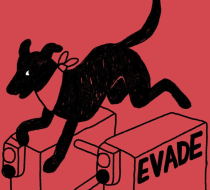Negro Matapacos Favorite
The streets of Santiago are once again alive with the spirit of revolution. For weeks now, working-class Chileans have occupied national monuments and blocked major intersections in protest of widespread inequality. They desire full reform — a request so long in the making that it is practically tradition. The country’s floundering political elite offer half measures while dispatching riot police and the military. Protestors stand their ground nonetheless, harnessing the raw energy of previous movements.
The image of a black dog in a red bandana appears throughout the crowds and on social media, commemorating the bravery of a stray who once marched with rioters and defended them from authorities. This canine rebel, named Negro Matapacos (or “Black Cop-Killer”), gained popularity during the student demonstrations of 2011-2013. Illustrator Maldito Perrito recently adapted his likeness to advocate for metro fare evasion in the midst of the #EvasiónMasiva protests, sparked by a recent fare hike. In the image, which went viral on social media, Matapacos hops a turnstile while casting a mischievous sidelong glance, with the word EVADE written in bold lettering.
Widely regarded as a champion of the working class, Matapacos first showed up in 2010, just as students began organizing for free education. The young radicals knew him as a faithful comrade who endured tear gas and water cannons, and who only ever attacked or barked at pacos (Chilean slang for cops). Over the next few years, he became ubiquitous at events that brought together groups from the Central University of Chile, the University of Santiago de Chile, and the Metropolitan University of Technology. Tributes from this time include a documentary by Saint Tomás University students and a mural at the USACH School of Journalism by artists from 12 Brillos.
Artists continue to transform Matapacos into a contemporary Chilean folk hero by sharing their own designs and photos of other people’s posters, flags, and murals. A symbol of revolt in black and red — the colors of anarcho-syndicalism — Chile’s beloved protest dog represents instinctive duty, a natural tendency to stand up and fight back. The good boy passed away from old age in 2017, but his legacy endures as Chile’s population faces the same oppression.
High costs of living and the privatization of social services are driving the most intense public outcry in Chile since the end of Pinochet’s dictatorship. Demands for fairer pensions follow decades of incremental pressures stemming from the neoliberal project, for which Chile has long been a testing ground. Since late October, President Sebastián Piñera has canceled economic and climate summits, replaced members of his Cabinet, and raised the minimum wage. Still, many Chileans are calling for his resignation using the hashtag #PiñeraRenuncia.
Many signs and posters memorialize Matapacos with phrases such as Estai Presente (“You Are Present”) and En Tu Memoria (“In Your Memory”) underscoring paintings and prints of his distinctive profile. One artist painted a halo on a cutout of his head and tied an actual bandana around the neck, writing Ladra Ladrale a la Autoridad (“Bark Bark at Authority”) underneath. Others took inspiration from religious iconography, proclaiming Patronos de las marchas, San Negromatapacos, cuidanos (“Patron of the marches, Saint Negro Matapacos, take care of us”).
Matapacos also turns up in colorful tarot card designs, further solidifying his spiritual influence. Matheuss Berant depicts him on his hind legs with the flag of Chile between his teeth, as a can of tear gas goes off in the foreground and smoke billows from a distant building. An indifferent sun contains traces of the graffiti tag Chile Despertó (“Chile Woke Up”), which the artist saw while out in the streets. Likewise, a design by Geni Riot titled La Fuerza (“The Force”) pairs Matapacos with a protestor affectionately petting him. The girl wears a school uniform and a green bandana of the organization La Campaña Nacional por el Derecho al Aborto Legal, Seguro y Gratuito (the National Campaign for the Right to Safe and Free Legal Abortion) around her arm. It speaks to the alliance of strength and intelligence guiding this new mass movement.
The legacy of Negro Matapacos clearly expands beyond Chile. Last week, stickers of Perrito’s illustration surfaced in Downtown Brooklyn, as hundreds of protestors hopped turnstiles to oppose police brutality. A Mexican artist’s depiction of Matapacos in the US shows that solidarity is transnational, and that any city could become the next Santiago. Until then, the fight continues.







